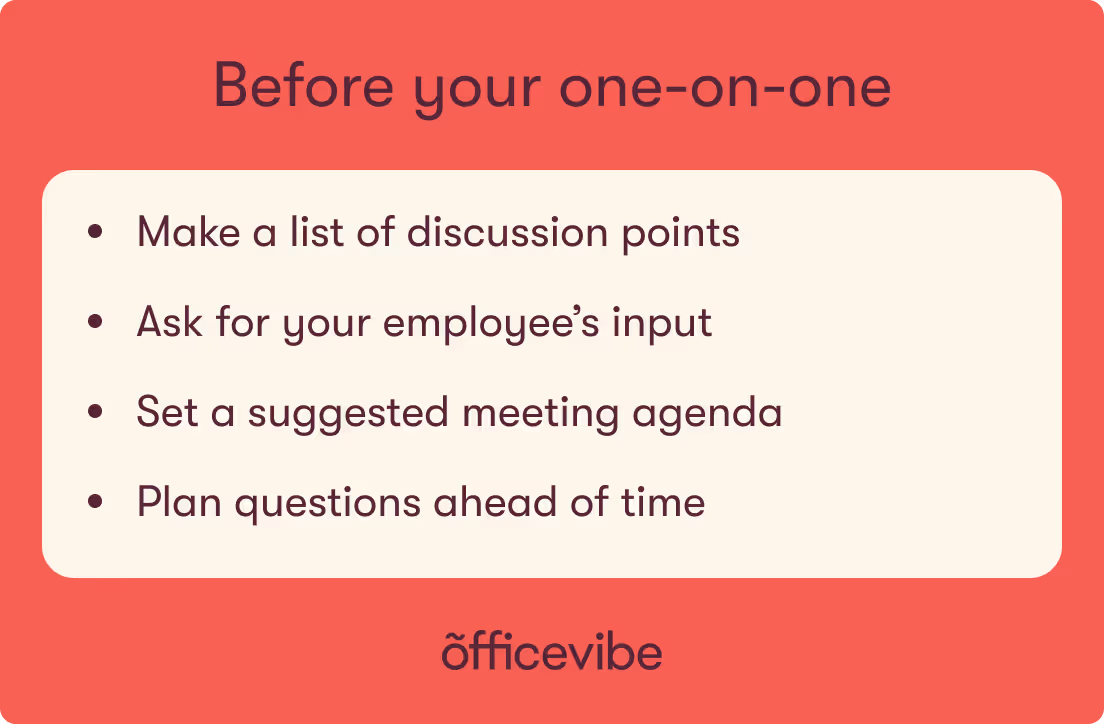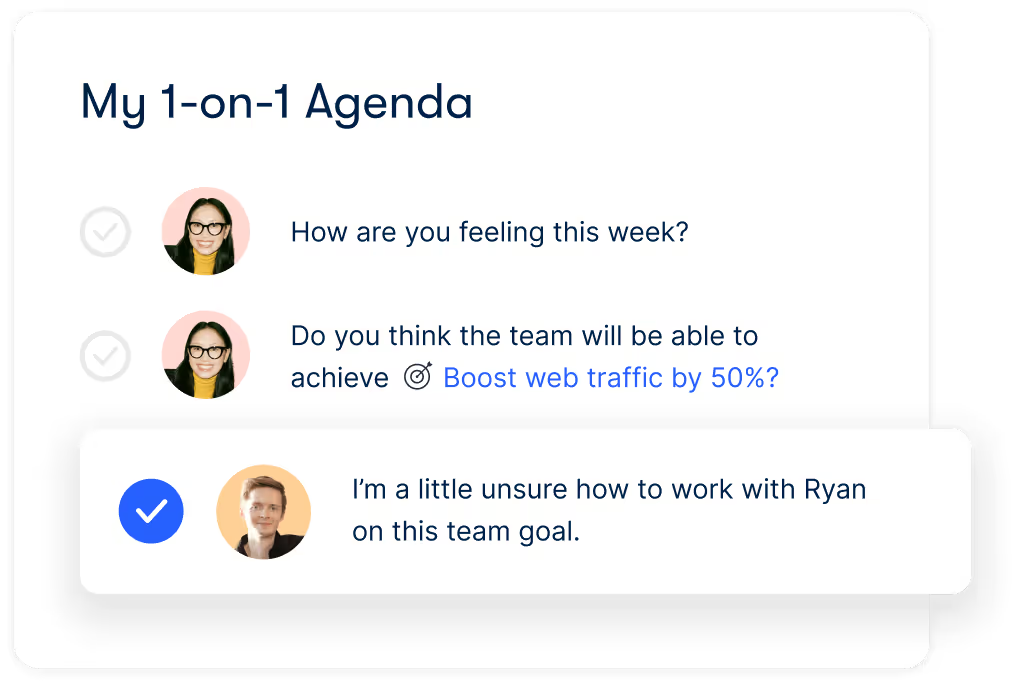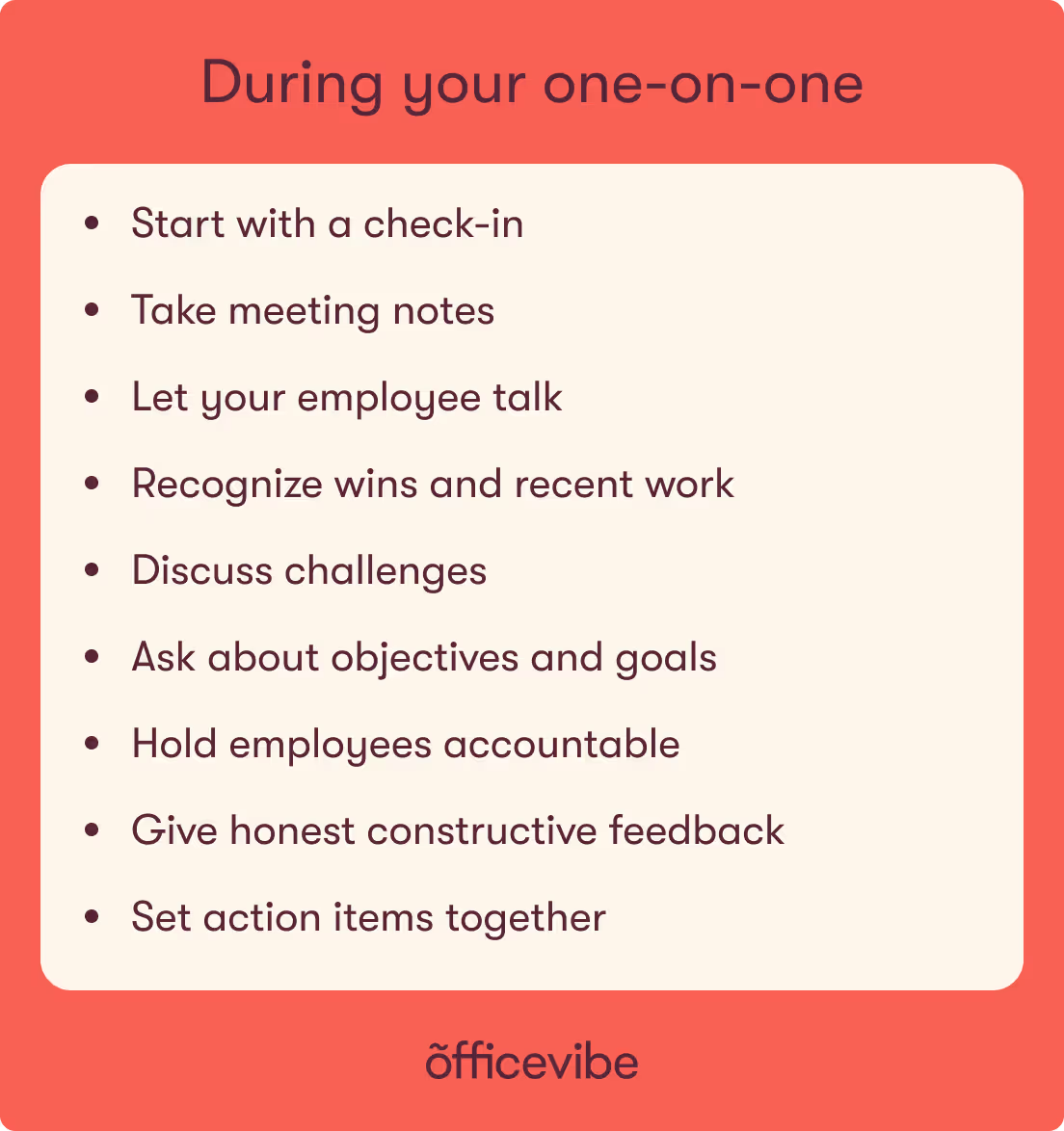The ultimate one-on-one meeting checklist

Discover Workleap Officevibe's benchmark report on 12 key employee engagement metrics

Being a successful manager means developing strong relationships with your employees, and one-on-one meetings are a big part of that. Beyond building those connections, there are several benefits of effective one-on-one meetings, from increasing employee engagement to boosting team productivity and alignment. Showing up prepared for these important conversations and using the proper meeting tools helps you make the most out of them.
We don’t want to add to your already heavy work pile, so we built the ultimate one-on-one meeting checklist to help you out. Use it to prepare for your one-on-ones on the go, and turn every meeting into a productive conversation.
Of course, these conversations are always a bit different. So feel free to use it as a reference, and take what’s most relevant to you and skip what isn’t.
Before your one-on-one meeting checklist

Make a list of discussion points
Every one-on-one is different, and depending on the situation, the conversation topics will vary. Making a list of talking points before creating your agenda helps you establish your priorities. Whether it's exchanging feedback, setting some development goals, or discussing a specific issue, listing everything out helps you organize your conversation.
Ask for your employee's input
Once you have your talking points, ask your employee if they have specific topics they'd like to discuss. This shows your direct reports that you care, and that you take their opinion into account. It gives them the opportunity to bring up anything you might be missing.
Set a suggested meeting agenda
After you’ve established the key points you want to touch throughout your meeting, create an agenda of how you'll carry out the meeting. This gives you a structure you can go back to whenever you want to move the conversation forward, and helps you keep the meeting efficient. A one-on-one meeting template can help you create an overall structure to use as a base.

Plan questions ahead of time
With one-on-one meetings, you can offer your employees a safe space to share their honest feedback, and open-ended questions are a good way to get them started. Think about what you’d like to know from your employees, and plan questions ahead of time so you get relevant information to support them.
If you ever need some ideas, here’s a list of one-on-one meeting questions you can use.
During the one-on-one meeting checklist

Start with a meeting check-in
Start with a meeting check-in to set the tone for a relaxed, friendly conversation, and find out how your employee is feeling. It's good to understand how each of you is coming into the conversation and what kind of mindset you're in.
Especially if you're having a virtual one-on-one meeting, don’t be afraid to dedicate some time to ask about or share something unrelated to work. Talking about the things you like to do outside the office helps you establish a connection on a personal level, which helps build trust and strengthen the relationship.
Take meeting notes
Writing down relevant points is a good practice that helps you to keep track of all the moving parts on your team. Maybe they’ll ask about something you’re not sure about and have to find out, or there will be an action item you need to add to your to-do list.
These notes will also help you when you need to give your direct report a performance review in the future. Relying on notes is much safer and effective than relying solely on memory!
Keep track of all your one-on-one meeting notes with Officevibe's one-on-one software. Build collaborative agendas and set action items that carry over to your next conversation, so no next steps fall through the cracks.
Let the employee talk and share the lead
Remember that a one-on-one meeting is a dedicated space for you to listen and receive employee feedback. Keep your meeting agenda as a loose structure, and let your employees express themselves. It’s their time to share and your time to learn about them, coach them when needed, and provide support.
Recognize wins and recent work
Make sure to include wins in your talking points, and ask your team member if they have exciting work-related news to share. We all like to be appreciated, and there are real benefits to recognizing good work. Plus, it boosts employee morale, motivation, and engagement, and sets a positive vibe for the rest of the meeting.
Discuss challenges
We all have obstacles that stand between us and our objectives, and your employees will eventually encounter obstacles as well. It’s part of your role to support them while they work towards their goals. To be able to find possible solutions, you need to first know the problems. Discuss common pitfalls or current challenges, and work through possible ways to solve them together.
Ask about the employee's objectives
Ask about your employee’s professional goals, and try to think which team objectives or tasks would they be happy to take on as a way of growing into their professional aspirations. Knowing your employee’s goals will help you plan strategically to have the right people doing the right things to achieve optimal results.
Don't forget: Knowing your team member's professional aspirations helps you set meaningful one-on-one meeting goals with them. Think about what you want to achieve from your time together and centre your discussions around those goals.
Hold employees accountable
Follow up on projects, get status updates, and make sure the deadlines are being met. If there are delays, discuss why, and work together on a plan to prioritize and get things done. Establishing clear deadlines and having to commit to them can actually empower people to work more efficiently, and can help you to see measurable results. Just make sure you don't spend the whole meeting on this, since you probably cover these things in team meetings, too.
Give honest constructive feedback
Don’t be shy to give employee feedback in your one-on-ones whenever you feel it’s necessary. What are the things that your reports do best, and what are the things they could work harder at? Make sure to be clear, and be kind with negative feedback. They can’t possibly correct something if they don’t understand how could they improve, and they won't be motivated to apply feedback if it's not given with compassion.
Set individualized action items together
Create action items that help you tackle issues and find solutions. These "to do's" will not only set things into motion, but will also allow you to follow up, and again, hold your team members accountable. Both you and your direct report can be responsible for the action items you set together.
The next one-on-one meeting checklist

Follow up on talking points and action items
Remember, one-on-one meetings shouldn’t be an isolated event. They become truly effective when done consistently and routinely. Talk about the things that may have been left out last time, answer any pending questions, and follow up on action items. Following up not only helps you to move forward, but it also shows that you listened and you care.
Review your meeting priorities
Because each one of these meetings will be unique, you’ll need to establish the priorities you want to tackle at the next meeting. Maybe you’ll need to get back to your employee regarding resources inquiries, or a new upcoming project. Go over the priorities to discuss this time to make sure you tackle the most pressing issues before discussing less urgent stuff.
Status update and course correction
How are projects going? Avoid future problems by taking time to check on projects and tasks’ status. Offer some guidance when needed, and make sure that everything is still on schedule. If that's not the case, evaluate and plan accordingly to accomplish or modify individual or team goals.
Focus on the big picture
Part of your role is to find the alignment between your direct report's goals and the organizational goals. Discuss with your employees what they see (or wish to see) in their future. Evaluate organizational mandates and see where they align with your employee’s short and long-term goals.
Goal-setting and tracking progress
Ask your employee about their short- and long-term goals. If they’re not completely sure, that’s okay. You can brainstorm together what the future could look like, or at least put the question out there so there’s an active reflection about it. Exploring and discussing career goals and growth opportunities will help you coach and support people to flourish in their roles and grow professionally.
Find our top employee goal setting tips to help you set every team member up for success.
Make every one-on-one meeting a success
As you might have realized, many of these checklist items are interconnected. They follow from one to the next to make the conversation evolve, so you strengthen your work relationships and improve team productivity.
Use this as a tool that you can adapt depending on the type of conversation you might want to have, and make sure you cover what’s most important. This will help you run better one-on-one meetings, keep up with all your employee's needs, and support an engaged, high-performing team.
Give HR and managers the clarity, confidence, and connection to lead better every day.


%20(1).avif)


.avif)
.avif)








